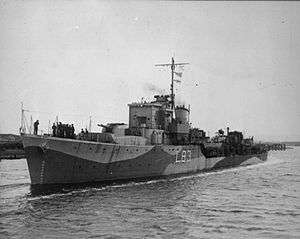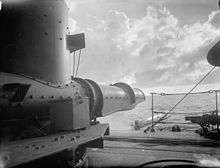HMS Derwent (L83)
HMS Derwent was a Hunt-class Type III destroyer escort of the Royal Navy. She was built by Vickers-Armstrongs, Barrow-in-Furness and served during the Second World War.
 | |
| History | |
|---|---|
| Name: | HMS Derwent |
| Ordered: | 4 July 1940 |
| Builder: | Vickers-Armstrongs, Barrow-in-Furness |
| Laid down: | 29 December 1940 |
| Launched: | 22 August 1941 |
| Commissioned: | 24 April 1942 |
| Identification: | Pennant number: L83 |
| Honours and awards: |
|
| Fate: | Scrapped in 1947 |
| Badge: | On a Field Blue, a stirrup Gold, over a rose White and two wings also White |
| General characteristics | |
| Class and type: | Hunt-class destroyer |
| Displacement: | 1,050 tons standard; 1,435 tons full load |
| Length: | 280 ft (85 m) |
| Beam: | 33 ft 4 in (10.16 m) |
| Draught: | 8 ft 3 in (2.51 m) |
| Propulsion: |
|
| Speed: | 27 knots (25½ knots full) |
| Range: | 2,350 nmi (4,350 km) at 20 knots (37 km/h) |
| Complement: | 168 |
| Armament: |
|
Construction and design
Derwent was one of seven Type III Hunt-class destroyers ordered for the Royal Navy on 4 July 1940, as part of the 1940 War Emergency Programme.[1] The Hunt class was meant to fill the Royal Navy's need for a large number of small destroyer-type vessels capable of both convoy escort and operations with the fleet. The Type III Hunts differed from the previous Type II ships in replacing a twin 4-inch gun mount by two torpedo tubes to improve their ability to operate as destroyers.[2][3]
The Type III Hunts were 264 feet 3 inches (80.54 m) long between perpendiculars and 280 feet (85.34 m) overall, with a beam was 31 feet 6 inches (9.60 m) and draught 7 feet 9 inches (2.36 m). Displacement was 1,050 long tons (1,070 t) standard and 1,490 long tons (1,510 t) under full load. Two Admiralty boilers raising steam at 300 pounds per square inch (2,100 kPa) and 620 °F (327 °C) fed Parsons single-reduction geared steam turbines that drove two propeller shafts, generating 19,000 shaft horsepower (14,000 kW) at 380 rpm. This gave a design maximum speed of 27 knots (50 km/h; 31 mph).[4] 345 long tons (351 t) of oil fuel were carried, giving a range of 3,700 nautical miles (6,900 km; 4,300 mi) at 15 knots (28 km/h; 17 mph).[5]
Main gun armament was four 4 inch (102 mm) QF Mk XVI dual purpose (anti-ship and anti-aircraft) guns in two twin mounts, with a quadruple 2-pounder "pom-pom" and three Oerlikon 20 mm cannon providing close-in anti-aircraft fire.[6][4] Two 21-inch (533 mm) torpedo tubes were fitted in a single twin mount, while two depth charge chutes, four depth charge throwers and 70 depth charges comprised the ship's anti-submarine armament. Type 291 and Type 285 radars was fitted, as was Type 128 sonar.[6][7]
Derwent was laid down at Vickers Armstrong's Barrow-in-Furness shipyard on 12 December 1940, was launched on 22 August 1941 and was completed on 24 April 1942.[1][8]
Service history

On 19 March 1943 while anchored in Tripoli harbour, Libya, Derwent was hit by a Motobomba (pattern-running torpedo) launched by an Italian aircraft.[9] Another, more specific source, says the destroyer was damaged by I./KG 54 and KG 77, which also sank the Ocean Voyager (7,174 grt), Greek steamer Vavara (1,654 grt).[10]
Derwent was beached to prevent her from sinking and was later temporarily repaired and towed to England. Some repairs were carried out, but the decision was taken to suspend work in January 1945 and she was reduced to the reserve, and finally scrapped in 1947.
Notes
- English 1987, p. 17
- English 1987, pp. 7, 12
- Lenton 1970, pp. 83, 85
- Lenton 1970, p. 97
- Whitley 2000, p. 147
- Gardiner & Chesneau 1980, p. 46
- English 1987, pp. 12–13
- Friedman 2008, p. 331
- Ciampaglia, Giuseppe (July 1999). "La sorprendente storia della motobomba FFF". Rivista Italiana Difesa (in Italian).
- Smith, Kindell and Bertke 2012, p. 68.
Publications
- Colledge, J. J.; Warlow, Ben (2006) [1969]. Ships of the Royal Navy: The Complete Record of all Fighting Ships of the Royal Navy (Rev. ed.). London: Chatham Publishing. ISBN 978-1-86176-281-8.
- English, John (1987). The Hunts: A history of the design, development and careers of the 86 destroyers of this class built for the Royal and Allied Navies during World War II. World Ship Society. ISBN 0-905617-44-4.CS1 maint: ref=harv (link)
- Friedman, Norman (2008). British Destroyers and Frigates: The Second World War and After. Barnsley, UK: Seaforth Publishing. ISBN 978-1-84832-015-4.CS1 maint: ref=harv (link)
- Gardiner, Robert; Chesneau, Roger, eds. (1980). Conway's All The World's Fighting Ships 1922–1946. London: Conway Maritime Press. ISBN 0-85177-146-7.CS1 maint: ref=harv (link)
- Lenton, H.T. (1970). Navies of the Second World War: British Fleet & Escort Destroyers Volume Two. London: Macdonald & Co. ISBN 0-356-03122-5.CS1 maint: ref=harv (link)
- Shores, Christopher; Massimello, Giovanni; Guest, Russell; Olynyk, Frank; Bock, Winfried (2016). A History of the Mediterranean Air War 1940–1945: Volume Three: Tunisia and the End in Africa: November 1942 – May 1943. London: Grub Street. ISBN 978-1-910690-00-0.CS1 maint: ref=harv (link)
- Whitley, M. J. (2000). Destroyers of World War Two: An International Encyclopedia. London: Cassell & Co. ISBN 1-85409-521-8.CS1 maint: ref=harv (link)
| Wikimedia Commons has media related to HMS Derwent (L83). |